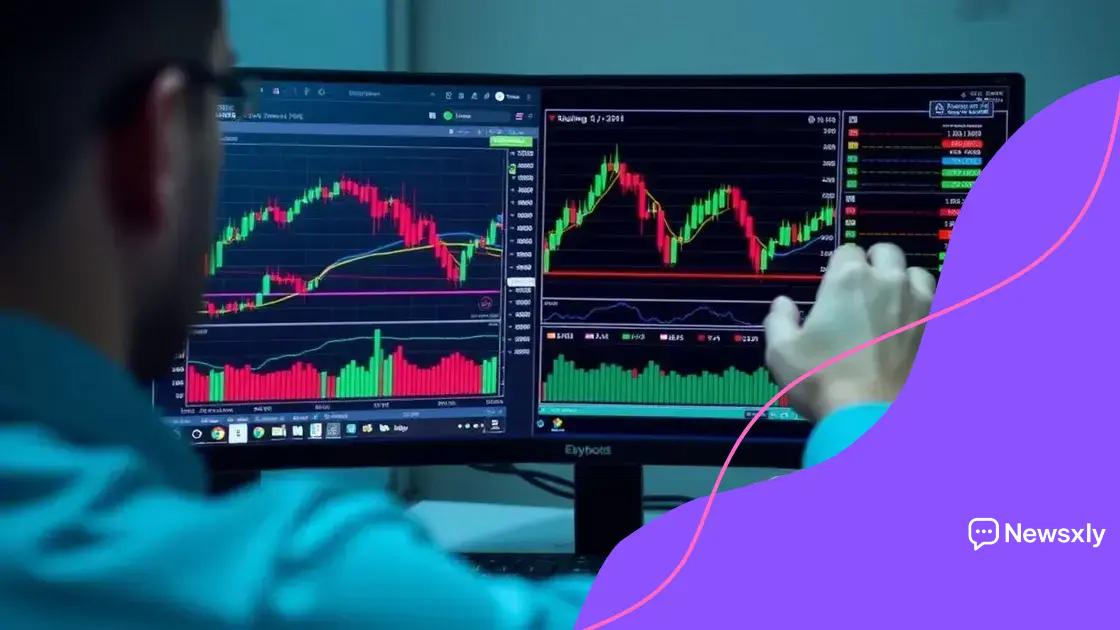Understanding cryptocurrency market volatility: A deep dive

Understanding cryptocurrency market volatility involves analyzing factors like market sentiment, regulatory changes, and technological advancements, which critically influence price fluctuations.
Understanding cryptocurrency market volatility is essential for anyone daring to invest in this fast-paced environment. Have you ever wondered why prices fluctuate so wildly? In this piece, we’ll uncover the factors behind those dramatic changes and how you can position yourself for success.
What drives cryptocurrency market volatility?
Understanding the factors that drive cryptocurrency market volatility is crucial for investors and enthusiasts alike. Various elements affect the price of cryptocurrencies, making them a unique investment option.
Market Sentiment
One of the primary drivers of volatility is market sentiment. People’s emotions and reactions to news can cause sudden price swings. Positive news may lead to a surge in buying, while negative news often results in panic selling.
Furthermore, social media plays a significant role in shaping public perception. Tweets from influential figures can move prices dramatically within minutes.
Regulatory Changes
Regulatory environments in different countries can greatly impact cryptocurrency prices. For example, a government announcement regarding new regulations may cause traders to react swiftly, leading to increased volatility. Some key points include:
- New tax laws affecting cryptocurrency trading.
- Government bans on certain platforms or currencies.
- Clarification of legal statuses for cryptocurrencies.
Staying informed about such changes is essential for making strategic investment decisions.
Market Manipulation
Sadly, market manipulation is not uncommon in the cryptocurrency world. Whales—large holders of cryptocurrency—can sway the market by making significant transactions. Their actions may create a ripple effect, causing smaller investors to react and further driving volatility.
Understanding these manipulative tactics can help investors safeguard against sudden market changes. Some examples include:
- Wash trading, where traders buy and sell to create artificial volume.
- Pump and dump schemes, which inflate a coin’s price only to sell off at the height.
Being aware of these activities allows traders to navigate the market more cautiously.
Technological Developments
Technological advancements can also lead to increased volatility. For instance, upgrades or forks in the cryptocurrency network can provoke investor excitement or fear, impacting prices. Additionally, new projects entering the market can change the dynamic rapidly.
Keeping an eye on these developments helps investors stay ahead. Market volatility isn’t entirely avoidable, but understanding its drivers offers an advantage.
Impact of news and events on crypto prices
The impact of news and events on crypto prices cannot be underestimated. News can spread rapidly, influencing investor sentiment and leading to price fluctuations. Understanding how different types of news affect the market is key to navigating the landscape of cryptocurrency investment.
Breaking News
When major news breaks, such as regulatory announcements or major hacks, the market often reacts sharply. Investors tend to make quick decisions based on the information available. This can lead to sudden drops or spikes in prices.
For example, a government decision to ban cryptocurrency trading can result in panic selling, while positive news, like a country adopting Bitcoin as legal tender, can lead to a considerable price surge.
Influence of Social Media
Social media has become a significant platform for disseminating news related to cryptocurrencies. Tweets from influential figures or trending topics can drive prices up or down significantly. Some important aspects include:
- The role of influencers in shaping market perception.
- Viral trends that can trigger buying frenzies.
- The emergence of online communities discussing market conditions.
These factors can result in a volatile market, where prices can change rapidly based on the latest tweets or posts. Understanding this dynamic is instrumental for investors aiming to make informed decisions.
Scheduled Events
Events such as conferences, launches of new technologies, or updates to existing platforms can also sway crypto prices. These events often generate excitement in the market. For instance, the anticipation of a new software upgrade can lead to increased buying activity. Similarly, events like ICO (Initial Coin Offering) announcements can attract attention and influence investor behavior.
Being aware of upcoming events allows investors to anticipate potential price movements and make strategic decisions accordingly. Monitoring these occurrences helps in crafting a responsive investment strategy.
How to analyze market trends effectively

Analyzing market trends effectively is essential for anyone involved in cryptocurrency trading. Understanding how to spot these trends allows investors to make educated decisions, maximizing their chances of success.
Identifying Trends
To start, you need to identify whether the market is in an uptrend, downtrend, or sideways movement. Uptrends are characterized by higher highs and higher lows, while downtrends show lower highs and lower lows. A sideways trend indicates the price is moving within a range. Recognizing these patterns helps you determine the overall market direction.
Another important aspect is looking at historical data. Analyzing the past performance of a cryptocurrency can provide insight into future behavior. Investors should closely examine:
- The currency’s reaction to past market events.
- Volume variations during different price movements.
- Historical support and resistance levels.
Using Technical Indicators
Technical indicators can also aid in analyzing market trends. These tools help visualize price movements and identify potential buy or sell signals. Some commonly used indicators are:
- Moving Averages: These smooth out price data to identify the trend direction.
- Relative Strength Index (RSI): This indicates whether a cryptocurrency is overbought or oversold.
- Bollinger Bands: These show the volatility of prices and can indicate potential reversals.
Choosing the right indicators depends on your trading style and goals. Combining multiple indicators may offer a more comprehensive view of market trends.
Staying Updated with News
Staying informed about market news is crucial for effective analysis. News can significantly influence market trends; therefore, following relevant updates helps investors anticipate price movements. Key sources include:
- Cryptocurrency news websites.
- Social media platforms and forums.
- Influencers and market analysts.
Investors should develop a routine for checking the news and integrating insights into their analysis. Doing so will enhance their understanding of the market and the factors that drive trends.
Risk management strategies for investors
Risk management strategies are crucial for investors in the cryptocurrency market. With its inherent volatility, having a clear plan can help protect investments and ensure long-term success.
Diversification
One essential strategy is diversification. By spreading investments across various cryptocurrencies, investors can minimize risk. If one asset performs poorly, others may offset that loss. It’s important to consider:
- Investing in both well-established coins and promising altcoins.
- Including different asset classes, such as stocks or commodities.
- Regularly reviewing and adjusting your portfolio.
Setting Stop-Loss Orders
Another effective strategy is using stop-loss orders. These orders automatically sell a cryptocurrency when it reaches a specific price, helping to limit potential losses. Key benefits include:
- Reducing emotional trading decisions.
- Ensuring losses are capped at a predetermined level.
- Providing a systematic approach to selling.
Investors should determine their stop-loss levels based on their risk tolerance and trading strategy.
Continuous Learning and Adaptation
Investors must stay informed about market trends and changes. Continuous learning allows them to adapt their strategies as needed. This includes understanding new technologies, updates, and regulations that could affect the market. Some effective ways to stay updated are:
- Following reputable news sources and influencers.
- Participating in online forums and communities.
- Attending webinars and conferences.
By being proactive and informed, investors can navigate market shifts more effectively.
Future outlook for cryptocurrency volatility
The future outlook for cryptocurrency volatility is intricate and dynamic. As the market evolves, several factors will continue to influence price fluctuations and investor behavior. Understanding these elements is vital for anyone looking to navigate the future of cryptocurrency.
Emerging Technologies
New technologies can significantly impact market volatility. For example, advancements in blockchain technology, improvements in transaction speeds, and enhanced security features may affect how cryptocurrencies are perceived and used. These innovations can lead to more widespread adoption, influencing market stability.
Moreover, improved infrastructure for trading and exchanges can reduce the likelihood of sudden price swings. As more investors enter the space, we might see a shift towards a more predictable market environment.
Regulatory Developments
The regulatory landscape will also play a crucial role in the future of cryptocurrency volatility. Governments around the world are continually working on frameworks to manage cryptocurrency investment and trading. Clear regulations can lead to increased legitimacy and investor confidence.
Some potential impacts of regulatory changes include:
- Reduction in fraudulent activities and scams.
- Enhanced protection for investors.
- Increased institutional investment, stabilizing the market.
Market Sentiment and Awareness
The role of market sentiment cannot be underestimated. As public awareness and understanding of cryptocurrencies grow, the nature of price movements may change. A well-informed investor base could lead to less emotional trading, leading to reduced volatility.
Increased education can empower investors to make more rational decisions, avoiding panic selling or irrational buying. Community-driven initiatives and reputable information sources will play a significant role in shaping positive sentiment towards cryptocurrencies.
FAQ – Frequently Asked Questions About Cryptocurrency Market Volatility
What factors drive cryptocurrency market volatility?
Factors such as market sentiment, regulatory changes, and technological advancements play significant roles in driving cryptocurrency market volatility.
How can I manage risks when investing in cryptocurrencies?
Investors can use strategies like diversification, setting stop-loss orders, and staying informed about market news to effectively manage risks.
How does market news impact cryptocurrency prices?
Market news can cause sudden price swings; positive news can lead to buying frenzies, while negative news can trigger panic selling.
What is the future outlook for cryptocurrency volatility?
The future of cryptocurrency volatility may involve more stability due to improved regulations, technology, and better investor education.





